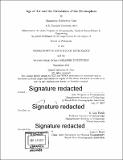| dc.contributor.advisor | R. Alan Plumb. | en_US |
| dc.contributor.author | Linz, Marianna Katherine | en_US |
| dc.contributor.other | Woods Hole Oceanographic Institution. | en_US |
| dc.date.accessioned | 2018-02-16T20:06:22Z | |
| dc.date.available | 2018-02-16T20:06:22Z | |
| dc.date.copyright | 2017 | en_US |
| dc.date.issued | 2017 | en_US |
| dc.identifier.uri | http://hdl.handle.net/1721.1/113801 | |
| dc.description | Thesis: Ph. D., Joint Program in Oceanography (Massachusetts Institute of Technology, Department of Earth, Atmospheric, and Planetary Sciences; and the Woods Hole Oceanographic Institution), 2017. | en_US |
| dc.description | Cataloged from PDF version of thesis. | en_US |
| dc.description | Includes bibliographical references (pages 105-114). | en_US |
| dc.description.abstract | The circulation of air in the stratosphere is important for the distribution of radiatively-important trace gases, such as ozone and water vapor, and other chemical species, including ozone-depleting chlorofluorocarbons. Age of air in the stratosphere is an idealized tracer with unique mathematical properties, which we exploit to derive a theory for the relationship of tracer observations to the stratospheric circulation. We show that the meridional age gradient is a measure of the global diabatic circulation, the total overturning strength through an isentropic surface, and test this time-dependent theory in a simple atmospheric general circulation model. We apply the theory to satellite data of sulfur hexafluoride (SF6 and nitrous oxide to derive the first observationally-based estimates of the global meridional overturning circulation strength at all levels in the stratosphere. These two independent global satellite data products agree to within 5% on the strength of the diabatic circulation in the lower stratosphere. We compare to re-analyses and find broad agreement in the lower stratosphere and disagreement (~ 100%) in the upper stratosphere. To understand the relationship between the diabatic circulation and other metrics of the circulation, we calculate it in a state-of-the-science atmospheric model and in three different reanalysis data products. The variability of the global diabatic circulation is very similar to one typical circulation metric, and it is correlated with total column ozone in the tropics and in Southern hemisphere mid latitudes in both a model and in reanalysis-data comparisons. Furthermore, we develop a metric for the mean adiabatic mixing, showing that it is related to the meridional age difference and the vertical gradient of age. We calculate this metric for a range of simple model runs to determine its utility as a measure of mixing. We find very little mixing of air into the tropics in the mid-stratosphere, and the vertical structure of mixing in the lower stratosphere and upper stratosphere varies among model runs and between hemispheres. A picture of global average stratospheric circulation could thus be obtained using age of air data, given reliable long-term records. | en_US |
| dc.description.statementofresponsibility | by Marianna Katherine Linz. | en_US |
| dc.format.extent | 114 pages | en_US |
| dc.language.iso | eng | en_US |
| dc.publisher | Massachusetts Institute of Technology | en_US |
| dc.rights | MIT theses are protected by copyright. They may be viewed, downloaded, or printed from this source but further reproduction or distribution in any format is prohibited without written permission. | en_US |
| dc.rights.uri | http://dspace.mit.edu/handle/1721.1/7582 | en_US |
| dc.subject | Joint Program in Oceanography. | en_US |
| dc.subject | Earth, Atmospheric, and Planetary Sciences. | en_US |
| dc.subject | Woods Hole Oceanographic Institution. | en_US |
| dc.subject.lcsh | Stratospheric circulation | en_US |
| dc.subject.lcsh | Stratosphere | en_US |
| dc.subject.lcsh | Ozone | en_US |
| dc.title | Age of air and the circulation of the stratosphere | en_US |
| dc.type | Thesis | en_US |
| dc.description.degree | Ph. D. | en_US |
| dc.contributor.department | Joint Program in Oceanography | en_US |
| dc.contributor.department | Woods Hole Oceanographic Institution | en_US |
| dc.contributor.department | Massachusetts Institute of Technology. Department of Earth, Atmospheric, and Planetary Sciences | |
| dc.identifier.oclc | 1022948732 | en_US |
